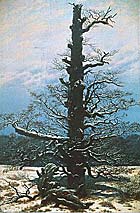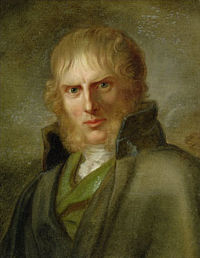The German Romantic Landscape Painter - Caspar David Friedrich
By Annette Labedzki
Nineteenth century, German 'Romantic' landscape painter, Caspar David Friedrich was born on September 5, 1774, in Greifswald, to candle-maker, Adolf Gottlieb Friedrich and Sophie Dorothea Bechly. By the age of thirteen, Caspar had lost his mother, sister, and brother.
His artistic career began with his coaching under Johann Gottfried Quistrop, a friend of the 'Romantic' poet, Ludwig Theobul Kosegarten. Ludwig introduced Friedrich to 'Romanticism' and willed him to develop his own faculty of analyzing picturesque landscapes. Ludwig, himself fascinated by 'Megaliths' in architecture, encouraged Friedrich to give place to local 'Megaliths' as his artistic themes. From 1794 to 1798, the painter studied at the Academy of Copenhagan, concentrating solely on understanding the intricacies of 'landscape painting.'
In 1798, Friedrich migrated to the German center of the 'Romantic Movement' in Dresden. Here he met painter Philipp Otto Runge and poets, Novalis & Ludwig Tieck. In addition, here, Friedrich forayed into printmaking with etchings and woodcuts, which were exclusively designed for some very close friends of his. In 1805, the artist won a prize for two of his 'Sepia' drawings, "Procession at Dawn" and "Fisher-Folk by the Sea," at a Weimar Competition.
Friedrich's first major painting, "The Cross in the Mountains (1807)," an altarpiece panel, depicted a crucified Christ in the midst of natural surroundings. This painting became trendsetter, as for the first time an altarpiece carried landscapes. Another work of his, "Abbey under Oak Trees (1809-10)," centered on a death scene, was donated to the Berlin Academy in 1810. During this period, 'Mysticism' encircled Caspar David's style of painting, with a smooth blending of 'Realism' and 'Romanticism'. In his 'allegorical' landscape paintings, inconsequential figures seem contemplative, enamored by the vastness of nature, and transfixed in its enigma. In his dramatic painting, "Monk by the Sea (1809)," a lonely figure is portrayed, exposed to the echoing sounds of the vast sea.
In 1816, Friedrich entered the Dresden Academy, and held the post of an Assistant Professor in 1824. On January 21, 1818, he married Caroline Bommer, after which his paintings began exhibiting a transition towards a more 'figurative' style. This change was a direct result of the change in Caspar's personal circumstances, where he started attaching greater importance to human life and relationships.
Friedrich's career as a painter flourished under the patronage of Grand Duke Nikolai Pavlovich and poet Vasily Zhukovsky. During his later years, his paintings came under criticism for being too bleak and devoid of emotions. Due to this, his popularity took a beating. His works during this period were representative of mainly, ship and harbor scenes, while some of them dealt with the human lifecycle. His melancholy mood, prevalent around this time, was symbolized in his paintings, where he often delved in the themes of the threshold between life and death.
In 1835, Caspar David suffered a stroke, which left him incapacitated to paint further. He died five years later on May 7, 1840. He was an exception of his times, his works touching the innate romantic strings in the heart of the onlooker. Throughout, he considered himself an interpreter of the nature's glory. Caspar David Friedrich's most magnificent works include "Old Heroes' Graves (1812)," "The Cross Beside The Baltic (1815)," "Moonrise Over The Sea (1822)," "Graveyard Under Snow (1826)," "The Oak Tree in the Snow (1829)," and "Seashore by Moonlight (1835-36)."
Annette Labedzki received her BFA at the Emily Carr College of Art and Design in Vancouver, B.C. Canada. She has more than 25 years experience. She is the founder and developer of an online art gallery featuring original art from all over the world. It is a great site for art collectors to buy original art. Is is also a venue for artists to display and sell their art . Artists can join for free and their image upload is unlimited. Please visit the website at http://www.labedzki-art.com
Article Source: http://EzineArticles.com/?expert=Annette_Labedzki
http://EzineArticles.com/?The-German-Romantic-Landscape-Painter---
Caspar-David-Friedrich&id=1931704
|





